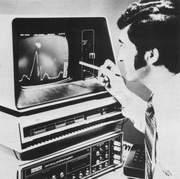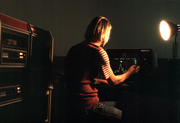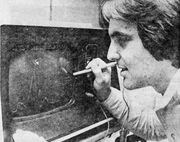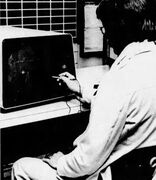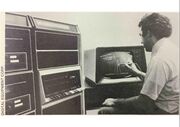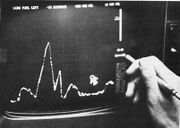Moonlander: Difference between revisions
From Video Game Morgue File
m Added history section |
MorticianBot (talk | contribs) m Bot: Changing template: Infobox |
||
| Line 1: | Line 1: | ||
{{ | {{InfoboxGame | ||
|image = 1976-11 Byte pg 57 01.jpg | |image = 1976-11 Byte pg 57 01.jpg | ||
|title = Moonlander | |title = Moonlander | ||
|developer = Jack Burness | |developer = Jack Burness | ||
|date = February 1973 | |date = February 1973 | ||
|mobygames = https://www.mobygames.com/game/mainframe/moonlander | |mobygames = https://www.mobygames.com/game/mainframe/moonlander}} | ||
}} | |||
''Moonlander'' was created as a demo program for the GT40 display terminal by Jack Burness in 1973. It is an adaptation of earlier text games involving the landing of a craft on the surface of the moon, initially inspired by the Apollo 11 moon landing. Transferred into a graphical realm on the GT40, ''Moonlander'' is notable for several gameplay innovations including touch screen gameplay via use of a light pen, separate zoomed out and zoomed in world screens, and an early instance of an authorial Easter Egg in computer software. | ''Moonlander'' was created as a demo program for the GT40 display terminal by Jack Burness in 1973. It is an adaptation of earlier text games involving the landing of a craft on the surface of the moon, initially inspired by the Apollo 11 moon landing. Transferred into a graphical realm on the GT40, ''Moonlander'' is notable for several gameplay innovations including touch screen gameplay via use of a light pen, separate zoomed out and zoomed in world screens, and an early instance of an authorial Easter Egg in computer software. | ||
Latest revision as of 13:29, 5 September 2024
Moonlander was created as a demo program for the GT40 display terminal by Jack Burness in 1973. It is an adaptation of earlier text games involving the landing of a craft on the surface of the moon, initially inspired by the Apollo 11 moon landing. Transferred into a graphical realm on the GT40, Moonlander is notable for several gameplay innovations including touch screen gameplay via use of a light pen, separate zoomed out and zoomed in world screens, and an early instance of an authorial Easter Egg in computer software.
Photos on Location
-
Moonlander being played at the National Computer Conference and Exposition. (1973)
-
Creator Jack Burness plays Moonlander. (1970s)
-
Player of Lunar Lander at a medical university. (1978)
-
Lunar Lander played on a GT40. (1978)
-
Man demonstrating Lunar Lander. (1973)
-
GT-40 terminal playing Lunar Lander. (1976)
Histories
- https://www.acriticalhit.com/moonlander-one-giant-leap-for-game-design/ — Moonlander: One Giant Leap for Game Design by Kate Willaert.
- https://www.technologizer.com/2009/07/19/lunar-lander/ — Forty Years of Lunar Lander by Benj Edwards.
